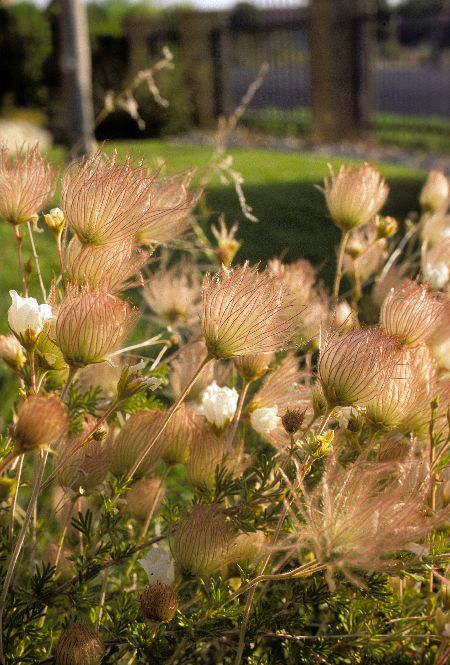
Fallugia paradoxa
Apache Plume
The showy seedheads of Apache Plume are more eye-catching than the small, roselike flowers. Seedheads are pinkish puffballs that light up in the sun. Form is irregular but still suitable as background or screen. Plants can be semievergreen. Canopy coverage: 13 square feet.
[Read More]Ficus carica
Fig Tree
Fig plants can be maintained at about any size and even work well as shrubby trees. If damaged by cold, they often regrow to take on a shrub form. Check locally for varieties best-suited to your region. Canopy coverage: 314 square feet.
[Read More]Forestiera neomexicana
Desert Olive
Train Desert Olive as a small tree or shrub. Appealing features include the light gray bark, which contrasts nicely with its bright green leaves. Attractive yellow fall color. Canopy coverage: 50 square feet.
[Read More]Frangula californica
Coffeeberry, California Buckhorn
This large shrub has a mounding and rounded growth habit. The common name Coffeeberry is due to its berries contain seeds that look like coffee beans. The berries are more of an attraction than its flowers, becoming red, then purple then black, and are loved by birds. Canopy coverage: 50 square feet.
[Read More]Frangula californica 'Leatherleaf'
Leatherleaf Coffeeberry
This shrub has a mounding growth habit. Its dark green foliage is very dark green, almost black. Common name Coffeeberry stems from the fact that its berries contain seeds that look like coffee beans. The berries are more of an attraction than the flowers, becoming red, then purple then black, and are loved by birds. Canopy coverage: 28 square feet.
[Read More]Fremontodendron species
Flannel Bush, Fremontia
These are large, sprawling shrubs grown for their incredible spring flower display and drought tolerance. Plant in well draining soil and do not water in summer. Leathery leaves are borne on stiff branches; the underside of leaves are covered in hairs that irritate the skin. Wear gloves when handling or pruning plants. Improved selections are available, including 'Ken Taylor', 'Pacific Sunset' (shown in photos) and 'California Glory'. Canopy coverage: 113 square feet.
[Read More]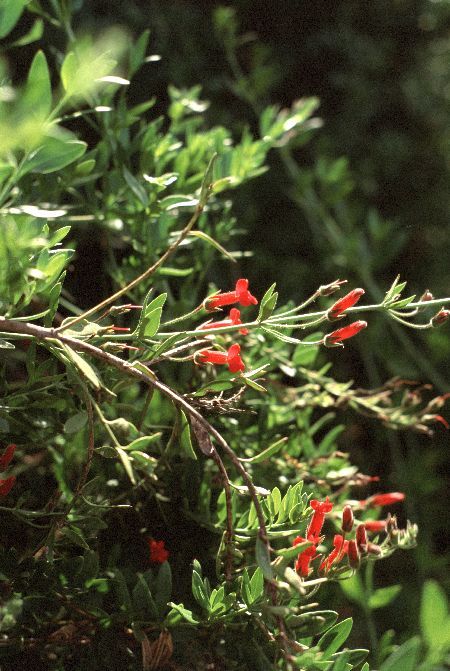
Galvezia speciosa
Island Snapdragon, Bush Snapdragon
The red flowers of Island Snapdragon make it a valuable commodity in the landscape. Forming at the branch tips, the 1-inch, tubular flowers are profuse during spring and into summer. Accepts full sun along the coast; prefers partial shade inland. Deadhead flowers past their prime; prune lightly to maintain form and set the stage for future blooms. Canopy coverage: 38 square feet.
[Read More]Garrya eliptica
Coast Silktassel, Silktassel Bush
This large, evergreen shrub makes a fine screen or hedge, or grow as a single specimen. Flowers are catkins, slender and spikelike flower clusters, that droop downward. Plants are either male or female. Females produce purple-shaded fruits that attract birds. Improved selections include 'Evie' and 'James Roof'; both are male plants with longer catkins (flowers). Canopy coverage: 113 square feet.
[Read More]Genista tinctoria 'Royal Gold'
Royal Gold Woadwaxen
The cultivar 'Royal Gold' Woadwaxen can be grown as a compact, rounded shrub or groundcover. It puts on a color show in summer with a profusion of pea-shaped, golden yellow flowers. Accepts almost any soil, even poor soil, as long as it is well drained. Canopy coverage: 7 square feet.
[Read More]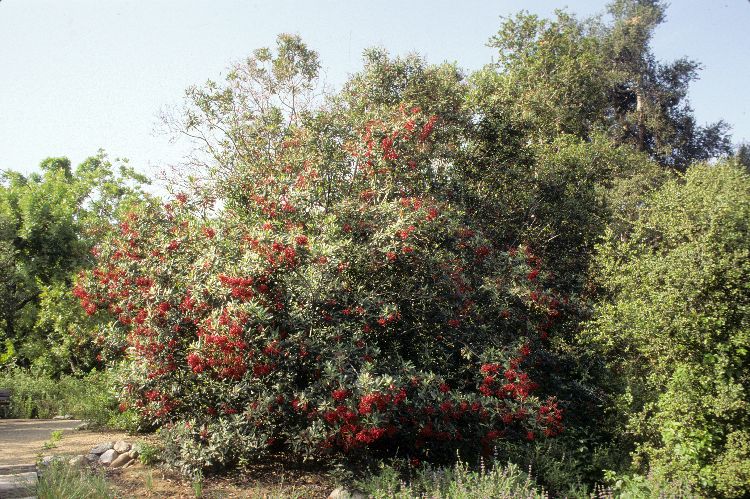
Heteromeles arbutifolia
Toyon
This is a handsome tall-growing shrub or small tree highly useful as a background or screen. Dark green leaves have serrated edges. Hollylike berries follow the summer flowers in fall, remaining on the plant into winter. Canopy coverage: 177 square feet.
[Read More]Hibiscus moscheutos
Rose Mallow
Rose Mallow is a shrubby perennial that can reach up to a towering 8 feet high. However, most hybrids fall into the 4-foot-high range. Very large flowers up to 12 inches across in a range of bright colors is a primary attraction. Dies to the ground in winter. Canopy coverage: 13 square feet.
[Read More]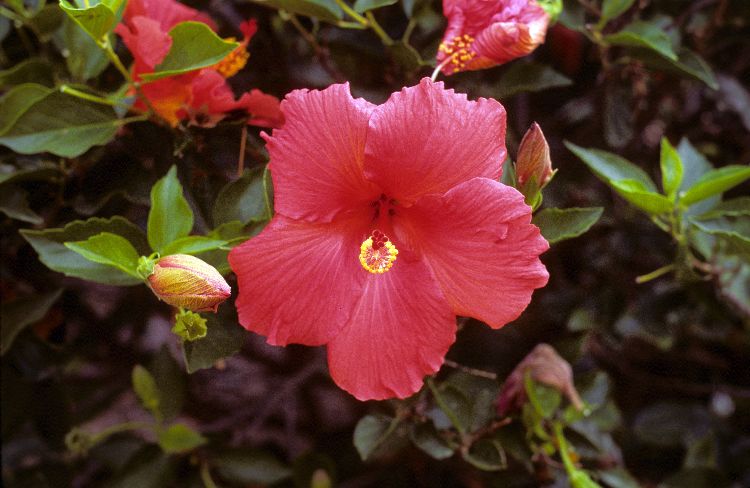
Hibiscus rosa-sinensis
Hibiscus
Tropical flowers and foliage are the attractions of Hibiscus. Protect against frost and wind. In hot-summer areas, avoid planting in locations exposed to long periods of afternoon sun. Canopy coverage: 50 square feet.
[Read More]Hibiscus syriacus
Rose of Sharon
When in bloom, Rose of Sharon reminds one of hollyhocks. It can be pruned to suit the needs of the landscape, from small tree to large, natural shrub or screen. Flowers are mostly shades of pink. Leaves have a coarse texture. Best with some protection from the sun in hot summer regions. Canopy coverage: 28 square feet.
[Read More]Juglans californica
California Black Walnut
California Black Walnut can be grown as a multi-trunk tree or large shrub. It provides valuable food (the small nuts are edible) and shelter to wildlife. Urban development threatens natural stands so it is a good tree or shrub to nurture if it exists on your property. Canopy coverage: 79 square feet.
[Read More]Juniperus californica
California Juniper
Form and mature size is highly variable. Stems and branches are irregular, with an open, upright shrubby form most common. Can become a tree with time, up to 40 feet high and as wide, but requires more moisture and deep, loose soil for this to occur. Light blue berries follow flowers, turning reddish brown at maturity. Canopy coverage: 314 square feet.
[Read More]Juniperus chinensis 'Sea Green'
Sea Green Juniper
You will notice this shrub Juniper in the landscape due to its fountainlike form. In addition to being an attractive specimen plant, it makes an admirable hedge or medium-sized screen. Best with some protection from the sun in hot summer regions. Canopy coverage: 28 square feet.
[Read More]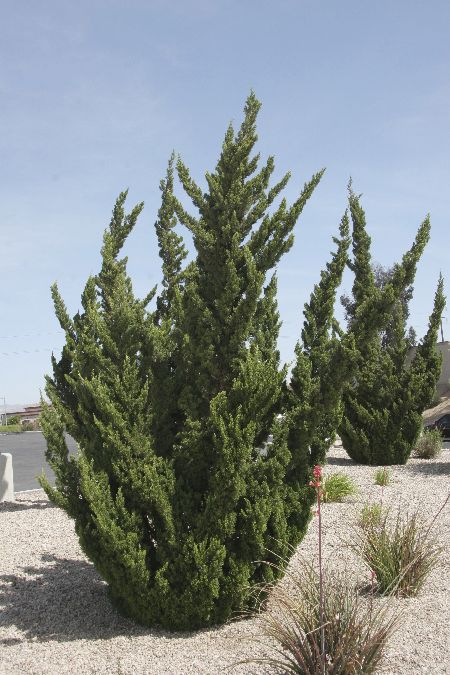
Juniperus chinensis 'Torulosa'
Juniper
Junipers are available in an extremely wide range of sizes, forms and foliage colors. They are easy-care, versatile plants once established. Avoid the temptation to prune or shape them—allow plant to maintain its natural form. Popular shrub types include 'Torulosa' and 'Pfitzerana'. Canopy coverage: 79 square feet.
[Read More]Juniperus communis
Common Juniper
Common Juniper is a workhorse shrub, particularly in tough conditions, including cold-winter climates. Resist the temptation to prune or shape Junipers and allow plants to maintain their natural form. Many improved selections are available; check locally. Canopy coverage: 28 square feet.
[Read More]Juniperus osteosperma
Utah Juniper
Utah juniper can be trained as a tree or large shrub. Despite its common name, it is the most common juniper in Arizona. Accepts dry rocky soils. Canopy coverage: 314 square feet.
[Read More]Juniperus sabina 'Buffalo'
Buffalo Juniper
Buffalo Juniper has appealing, bright green to olive green foliage. Leaves grow on long stems that spread horizontally close to the ground, forming a tight-knit mat. Accepts tough conditions. Attractive when it drapes and trails over ledges. Canopy coverage: 50 square feet.
[Read More]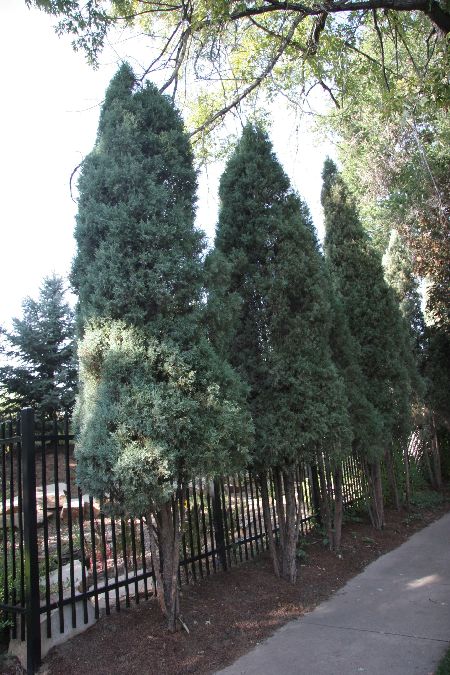
Juniperus scopulorum
Rocky Mountain Juniper
Many different selections of Rocky Mountain Juniper are available, with variable forms, textures and foliage color. Look for 'Skyrocket', blue-green foliage; 'Gray Gleam', blue-gray foliage, 'Blue Haven', deep blue-gray foliage; and 'Tolleson's Blue Weeping', drooping form with blue-gray leaves. Canopy coverage: 314 square feet.
[Read More]